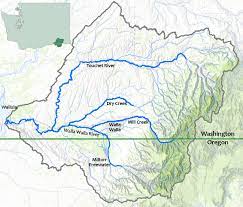The Confederated Tribes of the Umatilla Indian Reservation recently dedicated an enhanced, state-of-the-art hatchery that is expected to double the number of spring chinook salmon released into the Walla Walla River Basin annually.
The CTUIR’s long-term goal is to re-establish a self-sustaining, naturally spawning population of spring chinook in the South Fork Walla Walla River.
Located on the South Fork Walla Walla River about 9 miles east of Milton-Freewater, Oregon, the 33,000 square foot Walla Walla Spring Chinook Hatchery now supports full egg incubation and juvenile rearing capabilities, and has three new homes for hatchery workers.
The Bonneville Power Administration funded construction of the incubation and rearing infrastructure, which was built next to existing adult holding and spawning facilities. The agency will also provide the annual operation and maintenance costs for the entire facility as part of its mitigation responsibilities.
The hatchery is part of Northwest Power and Conservation Council’s Columbia River Basin Fish and Wildlife Program, which BPA funds. The program includes hundreds of BPA-funded projects each year that are implemented by tribes and other partners. Hatcheries, like the Walla Walla facility, are operated for species protection and population conservation. The majority of facilities in the Columbia Basin are operated to mitigate for the construction and operation of the federal hydropower system.
The newly upgraded hatchery will bring thousands more spring chinook salmon back to the area, providing the potential for fisheries in the mainstem Columbia River and Walla Walla Basin. The hatchery will play an important role in producing fish for tribal ceremonies and subsistence. It is the first hatchery fully owned and operated by CTUIR.
“This project is a critical component in the overall Walla Walla Basin water and fish restoration program with anticipated benefits for both Indian and non-Indian people,” said Gary James, CTUIR fisheries program manager. “The Tribe operates many hatchery satellite adult collection and juvenile acclimation stations in northeast Oregon, and we are looking forward to operating our first full hatchery facility.”
CTUIR plans to release up to half-a-million smolts into the river system each year beginning next spring. The hatchery received 170,000 juvenile spring chinook on July 19, jump-starting the onsite rearing capability for the Walla Walla River Basin. The first adults of the year were spawned at the hatchery Aug. 17, and juveniles developed from those eggs will be released in spring 2023. Within the next few years, fish spawned, reared and released from the hatchery will find their way to the sea and then return to the basin as adult chinook salmon.
The vision for the hatchery was born more than 30 years ago when tribal leaders were seeking a suitable location and saw that the water at the site is ideal for raising spring chinook salmon.
BPA committed to fund the hatchery in the Columbia Basin Fish Accords. Signed in 2008, the Accords pledged hundreds of millions of dollars in funding for projects, such as building and operating hatcheries.
“The Walla Walla hatchery clearly demonstrates the progress we can make for fish when we work together,” said Crystal Ball, director of BPA’s Fish and Wildlife Program. “Our partnerships with the tribes are critical to helping Bonneville meet its mitigation responsibilities and support the region’s goals for fish and wildlife.”
The CTUIR will use Walla Walla River water to incubate and rear young salmon before releasing them, helping the fish to imprint on their natal stream, potentially increasing their survivability and the ability to come back to their natal waters. The Tribe envisions a yearly goal of 5,000 adult chinook salmon originating from the hatchery to return to the river.
For Background, see:
— CBB, November 2, 2018, “Science Panel Reviews Monitoring/Evaluation Plan For Walla Walla Spring Chinook Hatchery,” https://www.www.www.columbiabasinbulletin.org/science-panel-reviews-monitoring-evaluation-plan-for-walla-walla-spring-chinook-hatchery/
— CBB, August 10, 2018, “Construction Expected To Begin Soon On New Walla Walla Hatchery To Produce 500,000 Salmon Smolts,” https://www.www.www.columbiabasinbulletin.org/construction-expected-to-begin-soon-on-new-walla-walla-hatchery-to-produce-500000-salmon-smolts/
— CBB, October 11, 2013, “Council Recommends Hatchery Expansion For Reintroducing Salmon To Walla Walla River,” https://www.www.www.columbiabasinbulletin.org/428636.aspx

